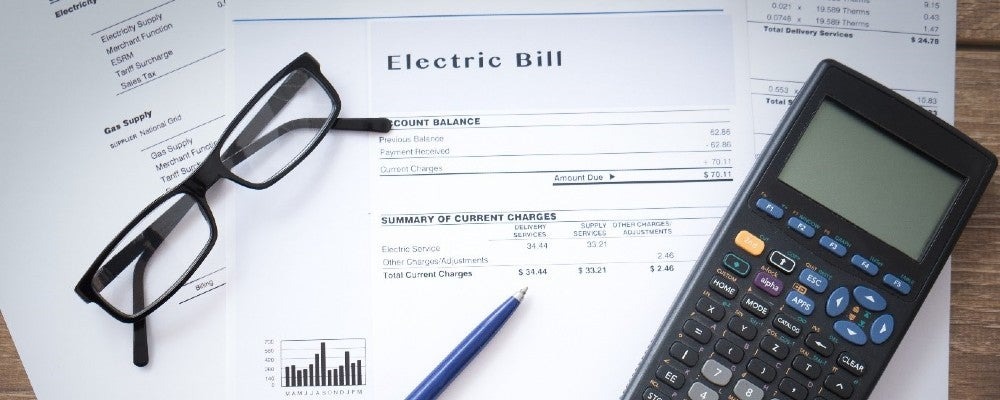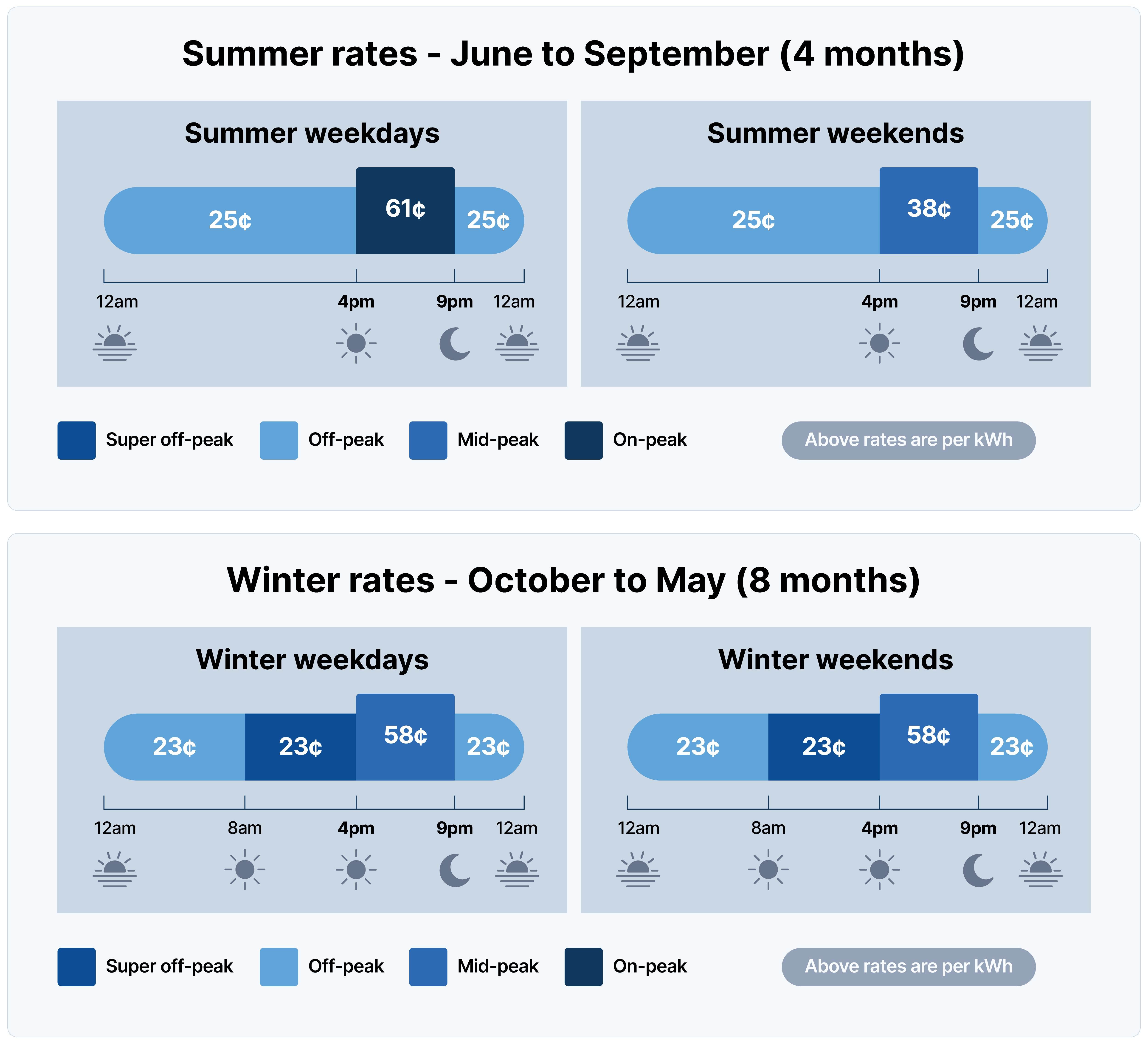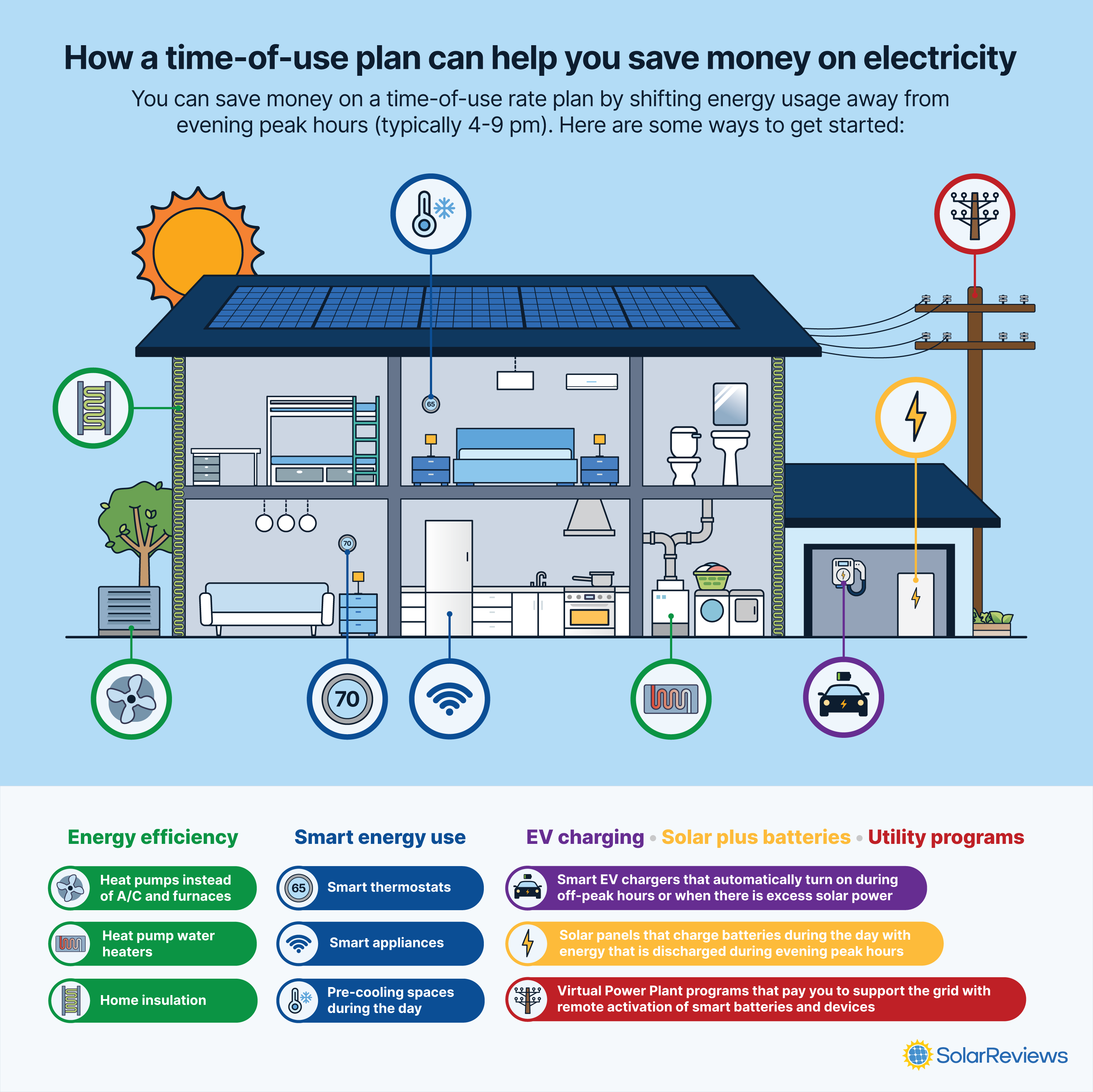Updated 9 months ago
Off-Peak Hours Explained: Is Electricity Cheaper at Night?
Written by
Ben Zientara

How much can solar panels save on your electric bill?
Key takeaways
-
Electricity is cheaper at night because there is lower demand on the grid at night, and it comes from inexpensive and abundant sources like large wind and nuclear plants.
-
Some utilities offer time of use billing plans, when electricity is usually cheapest at night.
-
Off-peak hours, when electricity is cheapest, usually run from 8 PM to midnight, and midnight to 4 PM.
-
On-peak hours usually span from 4 PM to 8 PM and are when electricity rates are highest.
-
Switching electricity usage to nighttime off-peak hours can lower your electricity bill, as can using energy efficient appliances, smart thermostats, and solar batteries.
Most people in the United States pay the same price for electricity whether it’s being used during the day or at night. But an increasing number of people are now on a new kind of electricity billing plan called time-of-use, or TOU for short.
Nearly all TOU plans have one thing in common: the price of electricity is cheapest at night. Why? Because at night there is less demand on the electric grid, so utilities charge less money for that energy.
This results in some great opportunities for homeowners to save money by shifting electricity usage (like electric vehicle charging) to night time. Some places in Texas even have “free nights” plans where you pay nothing for electricity during the night.
Below, we’ll break down what you need to know about shifting the use of electricity to the nighttime.
What is the difference between off-peak and on-peak hours?
Off-peak hours are when electricity demand is low, usually in the afternoon and at night. They typically span from 8 PM to 4 PM and are when electricity is cheapest.
Electricity tends to be cheapest at night because large power plants and wind turbines continue to produce electricity at night, even when demand is low. In fact, according to Lawrence Livermore National Laboratory, wind turbines even produce more power at night.
On-peak hours are the times of day when energy consumption and electricity prices are highest. They usually span from 4 PM to 8 PM. Demand is higher during these hours because it’s the end of typical work and school schedules, so people come home, run their appliances, and adjust their thermostats.
Because of the way most people tend to use energy, grid demand at night is lowest, making it so each kilowatt-hour of energy you use at night is usually cheaper than energy at other points in the day.
Electric companies offer TOU plans because it helps them avoid buying more electricity during times of high demand when it can get quite expensive. Many utilities have different peak hours during with winter and summer seasons and even different weekend hours.
Example of off-peak and on-peak hours
Southern California Edison offers one of the most popular TOU plans in the country. The rates shown below are part of their TOU-D-PRIME rate plan for residential customers.

SCE’s electricity prices differ by time period, weekday, and season.
For example, on summer weekdays, there are just two time periods: On-Peak, from 4 pm to 9 pm, and Off-Peak during all other hours. On summer weekends, the same hours apply, but the period from 4 pm to 9 pm is known as Mid-Peak, with a lower price per kWh.
In the wintertime, weekdays and weekends have identical rates. The period from 8 am to 4 pm is known as Super Off-Peak, 4 pm to 9 pm every day is Mid-Peak, and 9 pm to 8 am is Off-Peak (with the Off-Peak rate the same as Super Off-Peak).
10 most popular TOU plans
Not all electric providers are created equally. In places like Michigan and Missouri, TOU plans are mandated for residential customers. In California, anyone who gets solar panels installed must switch to a TOU plan, and there are optional plans for people with electric vehicles and other home electrification.
The table below lists some of the most popular time-of-use rate plans in the country offered by utility companies:
Electric company | State | Off-peak hours | Off-peak rate (per kWh) | On-peak hours | On-peak rate (per kWh) |
|---|---|---|---|---|---|
Consumers Energy | Michigan | 12 AM - 2 PM; 7 PM - 12 AM | $0.17 | 2 PM - 7 PM | $0.22 |
DTE Energy | Michigan | 12 AM - 3 PM; 7 PM - 12 AM | $0.18 | 3 PM - 7 PM | $0.22 |
Ameren | Missouri | 12 AM - 9 AM; 9 PM - 12 AM | $0.13 | 9 AM - 9 PM | $0.14 |
San Diego Gas & Electric | California | 12 AM - 4 PM; 9 PM - 12 AM | $0.45 | 4 PM - 9 PM | $0.68 |
Evergy Missouri West | Missouri | 12 AM - 4 PM; 8 PM - 12 AM | $0.13 | 4 PM - 8 PM | $0.14 |
PSEG Long Island | New York | 2 AM - 3 PM; 7 PM - 12 AM | $0.10 | 3 PM - 7 PM | $0.20 |
San Diego Community Power | California | 12 AM - 4 PM; 9 PM - 12 AM | $0.21 | 4 PM - 9 PM | $0.47 |
Southern California Edison (SCE) | California | 12 AM - 4 PM; 9 PM - 12 AM | $0.25 | 4 PM - 9 PM | $0.61 |
Sacramento Municipal Utility District (SMUD) | California | 12 AM - 8 PM; 8 PM - 12 AM | $0.20 | 5 PM - 8 PM | $0.35 |
*Based on the most popular TOU tariffs, electric rates are rounded, some plans may have super off-peak hours which are included in the off-peak hours in this table.
Texas free nights plans
Texas is a special place when it comes to time-varying electric rate plans. The state has a deregulated energy market, meaning most residential customers get to choose the supplier of their electricity.
Retail Electric Providers (REPs) compete for business across the state, offering various rate plans to entice customers to use their electricity. Some of these rate plans include free nights and/or weekends, which are offset with much higher energy costs during weekdays.
“Free nights” plans are very popular with people who have solar panels and/or batteries installed, because the solar can meet much of the home’s needs during the day, and the homeowner can draw free electricity from the grid at night.
Check out our complete guide to Texas solar buyback plans.
Best ways to take advantage of cheap electricity
When you have an electric rate plan with different prices for different times of the day, and your electricity bill is high, your best strategy is to shift your energy usage to the least expensive hours.
You can do this in a few ways: energy efficiency, smart thermostats and appliances, solar panels, and energy storage. These strategies can also help people on a standard flat-rate billing plan.

1. Smart energy usage
One of the best ways to pay less for electricity is to use your appliances at night when electricity is cheapest. If you can shift your usage of large appliances to off-peak hours, you can save a lot of money. So, consider starting your load of laundry at 8 PM instead of right after work to avoid using peak electricity.
Pre-cooling spaces is another one of the best ways to use energy in a smarter way. Simply set your thermostat to below your ideal temperature during the off-peak hours, and set it higher during on-peak hours. This will ensure your air conditioning doesn’t turn on in the afternoon and evening when electricity is expensive.
California utility company SDG&E recommends starting the pre-cooling process about 3 hours before on-peak hours begin. Another strategy that can be employed along with everything above is to consider exterior window shades or awnings to prevent heat gain through unshaded windows.
2. Smart appliances
Shifting energy usage from the evening hours to the middle of the night may be able to save you money, but the trade-off is you have to wait to use large appliances like dishwashers, washing machines and clothes dryers until late in the evening.
If you’re not the night-owl type, investing in smart appliances that can turn on automatically at a pre-set time is an excellent way to reduce your on-peak energy consumption. The low-tech version of this is just a “delay” button on the front of the machine, but many new appliances now come with smart home integration that allows you to set up routines to turn them on after you’ve gone to bed.
3. Energy efficiency upgrades and improvements
One of the fastest ways to change your electricity consumption patterns is to invest in energy-efficient appliances.
Choosing a heat pump over a traditional furnace and air conditioner for heating and cooling is an excellent first step. Heat pumps cost an average of $6,000 to install and are also far more efficient than baseboard heaters.
Speaking of heat pumps, EnergyStar.gov says that a heat pump water heater can save a family of four an average of $550 per year compared to an electric resistance water heater.
If you find your home tends to heat up quickly after you change the thermostat set point, you may not have enough insulation in your walls. Set up a home energy audit to discover any changes needed to make pre-cooling work for you!
All these changes can significantly reduce total energy use during peak times, and using them smartly ensures you avoid higher rates.
4. Solar batteries
Solar panels are one of the best ways to reduce your energy bills. That said, solar panels by themselves do not do enough to eliminate your electricity use during on-peak hours. For that, you need a solar battery.
Many of the top home solar batteries, like the Tesla Powerwall 3 or Enphase IQ 5P, can be programmed for solar self-consumption, which means they can charge up using extra solar energy during the day when electricity is cheap, and discharge later when electricity gets more expensive.
Getting a solar battery can be a complicated decision. If you have a small house, you may be able to get by using a small portable solar generator to run some important appliances for a few hours every day.
Batteries for solar self-consumption can save you a lot of money, especially in California, where anyone who goes solar has to sign up for the Net Billing tariff, which includes time-of-use rates and decreased credit for exported solar energy.
Many places even have solar battery incentives to help you pay for energy storage.
5. EV charging
Similar to Wi-Fi-connected smart appliances, many Level 2 EV chargers now offer smart functionality to turn on and off remotely or at pre-set times. Some EV chargers can even be set to charge the car when your solar panels are generating excess electricity.
Another great benefit of a smart EV charger is that your utility company probably offers an incentive to help you pay for one.
Many utility companies now have demand-response or virtual power plant programs that can take control of smart thermostats and EV chargers during times of high demand, turning them off until after the peak period has passed. In exchange for giving over that little bit of control, homeowners can earn payments from their utility company.
Final word on cheaper electricity at night
Perhaps sometime in the future, there will be enough batteries connected to the grid that there won’t be such a thing as peak demand, but until that time, electricity is going to cost more when more people want it.
By combining multiple strategies, you can significantly reduce your electricity usage during peak times. Energy savings lead to monetary savings!
In addition to the personal financial benefits, shifting energy usage to the nighttime keeps the grid stable during the hottest parts of the day and helps to reduce the utility company’s reliance on fossil fuel plants. You get to be a part of making that happen.
Ben Zientara is a writer, researcher, and solar policy analyst who has written about the residential solar industry, the electric grid, and state utility policy since 2013. His early work included leading the team that produced the annual State Solar Power Rankings Report for the Solar Power Rocks website from 2015 to 2020. The rankings were utilized and referenced by a diverse mix of policymakers, advocacy groups, and media including The Center...
Learn more about Ben Zientara